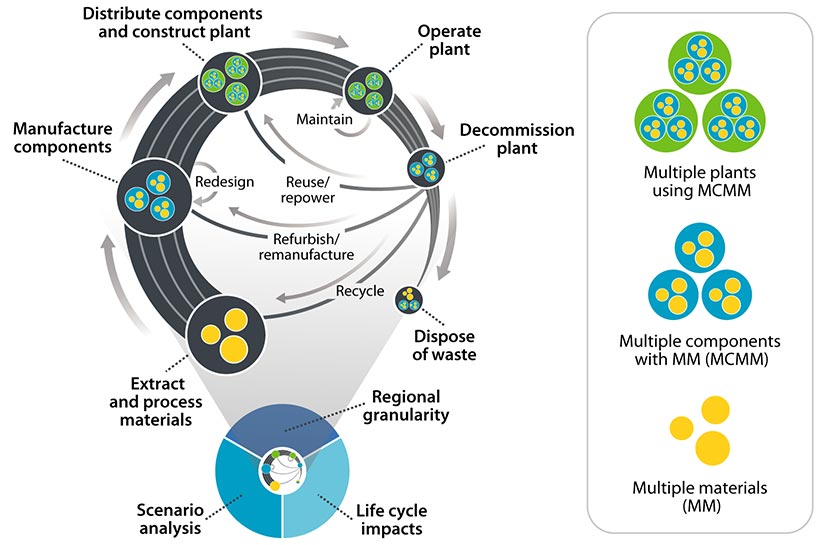CELAVI: Circular Economy Lifecycle Assessment and Visualization Framework
The Circular Economy Lifecycle Assessment and Visualization (CELAVI) framework is a dynamic and flexible tool that models the impacts of clean energy supply chains during the transition from a linear to a circular economy.

CELAVI (pronounced: c’est la vie) captures the environmental impacts of moving from a linear to a circular economy for energy materials—a traditionally difficult modeling challenge because of the complex nature of circularity transitions.
CELAVI users can explore circular and linear supply chains, as well as supply chains with varying degrees and types of circularities, to understand current and future technology demand, the state of technologies that enable circularity, and implementation over time.
The first version of the full CELAVI framework is available on GitHub.
Modeling Capabilities
CELAVI uniquely combines a discrete event simulation, life cycle assessment, and a network analysis model into a dynamic and flexible multiscale framework. CELAVI can represent system nonlinearities and environmental considerations as well as other externalities. The framework also captures impacts of circularity at the country, state, or county level.
Because transitioning from a linear to a circular economy will require new technologies, sources of raw materials, and markets for end-of-life clean energy materials, the transition will likely take many years or even decades. CELAVI can capture circularity transitions over time for many years to show how systems might evolve.
The CELAVI framework currently focuses on renewable energy power systems and materials, but the intent is to develop a flexible and modular approach that can be used in other applications as well.
Motivation
Many modeling methods exist for simulating circularity transitions, from discrete simulation to agent-based modeling. However, current approaches exclude market dynamics and economy-wide structural and sectoral changes. They also do not have a decision framework or uncertainty quantification.
CELAVI hybridizes existing methods to more accurately quantify and visualize potential regional advantages or disadvantages that could result from transitioning to a circular economy.
Uses
CELAVI can inform research prioritization and regional decisions related to circularity transitions. Governing bodies, corporations, and nongovernmental organizations at multiple levels that are working toward a circular economy may find it a useful tool.
CELAVI results could inform questions such as, what level of circularity could be reached with investment in new circularity technologies? How much technological learning needs to occur before circularity technologies reach cost parity with linear technologies? How does increasing circularity change the environmental impacts of renewable energy technologies?
Future Work
NREL analysts are continuing to modify CELAVI to add more capabilities. NREL plans to execute circularity case studies for multiple renewable energy power systems and expand the framework to incorporate other types of technologies like buildings or vehicles. Please contact us if you are interested in partnering on future CELAVI work.
Related Publications
The Circular Economy Life Cycle Assessment and Visualization Framework: A Multistate Case Study of Wind Blade Circularity in United States, Resources, Conservation and Recycling (2022)
The Circular Economy Life Cycle Assessment and Visualization Framework: A Case Study of Wind Blade Circularity in Texas, Frontiers in Sustainability (2021)
Contact
Share
